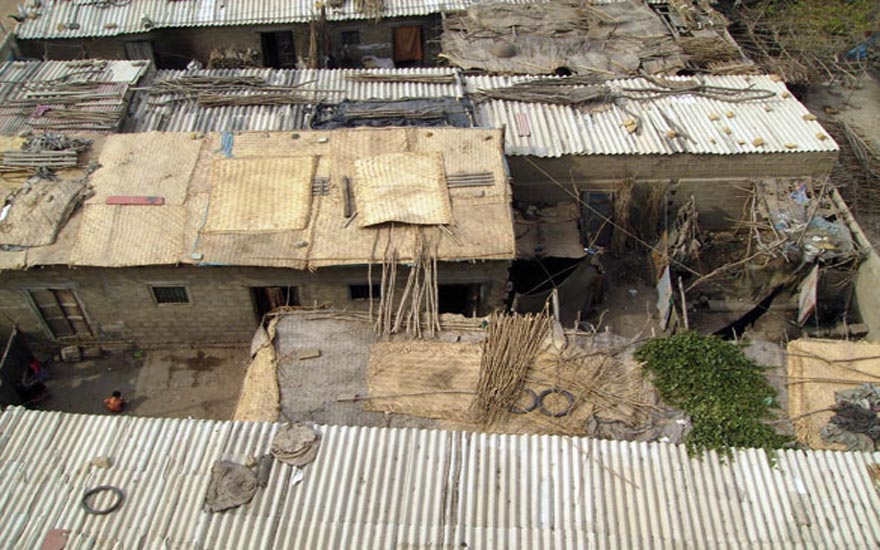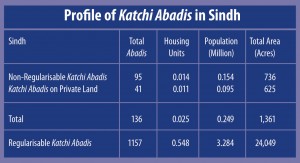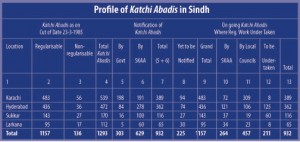An Unsettled Future
By Amna Khalique | News & Politics | Published 16 years ago
On January 8, 2009, a fire in a slum settlement, located in North Karachi, claimed the lives of at least 40 people, 22 of them children. Most of the bodies were charred beyond recognition. Ten days later, a fire broke out in six dwellings of a shanty town in Gulshan-e-Iqbal, claiming the life of an eight-month-old infant, Alishba.
Conflicting views were given in an inquiry by police officials, with some attributing the cause of the fire to thekunda system installed by the residents, whose houses caught fire when a live wire fell on one of them, while others alleged that a stove lit by one of the residents ignited the fire.
Whatever the case may be, the loss of both lives and property was devastating to the residents, most of whom were daily wage earners, dwelling in the shanties for the past 10-12 years.
According to a news report in a leading daily, in the past 10 years, almost 2,000 people have been burnt in such slum fires. Like the fire in North Karachi, these incidents are often catastrophic due to the lack of proper infrastructure. In the case of the North Karachi fire, the settlement had a single entry and exit point, enclosed by buildings from the other three sides. Currently, 55% of the population of Karachi lives in such squatter settlements.
The gravity of the situation that people from lower income groups face, was brought to the attention of the Sindh Assembly on April 22. A unanimous resolution was passed by the assembly to regularise 116 katchi abadis all across Sindh, with 39 of these located in Karachi. These abadis include Machar Colony, Dock Colony and Majeed Colony, among others. The abadis selected for regularisation are located on land belonging to the Karachi Port Trust, Pakistan Railways, DHA, Evacuee Trust and other federal land-owning agencies. This resolution urges the provincial government to approach the federal government to issue a No Objection Certificate (NOC), in order to regularise these settlements. This is an important step in the right direction because thousands of lives are involved. Regularising these settlements will also assist in the social and economic development of the province.
The lack of a housing plan for the poor has led most of the city’s lower-income population to seek refuge in settlements on illegally-occupied land. This is not a recent phenomenon but dates back to the time of Partition; the government, unable to provide housing for the migrants, led them to establish makeshift houses on vacant land. Karachi has since played host to several migrant communities, who come in search of employment to the city. While the government has failed to meet the housing needs of low-income groups, opportunists, in the shape of land grabbers, instead, provide housing to them by grabbing vacant land and systematically allotting plots at rates fixed by them, leasing or letting them out on rent. The land grabbers also illegally provide basic services such as water, electricity and sanitation. What were initially sporadic settlements have now turned into planned abadis. While these encroachments have addressed the plight of the poor, who at least now have shelter instead of sleeping out on the streets, these settlements are not granted legal status by the government and residents face the constant threat of eviction.
Take for instance, the case of the residents of Hazara Colony near Kalapul, Cantt., located on land owned by Pakistan Railways. Some of its residents have been living here for the past 30 years and have made this place their home. On February 7, 2009, according to a news report in Daily Times, officials from Pakistan Railways tried to launch an operation to evict some of the residents of the colony. Their operation was unsuccessful due to a massive protest by the residents who blocked the railway tracks, causing delays of three trains — Millat Express, Pakistan Express and Super Express.
The government agency responsible for addressing issues regarding katchi abadis in Sindh is the Sindh Katchi Abadi Authority (SKAA). One of its main functions is to regularise and then develop the abadis. The settlement, however, has to first qualify as a katchi abadi as per the official definition for it to be granted a legal status. Thus, the settlement should have been in existence before March 23, 1985, it must have a minimum of 40 dwelling units, it should not be on a hazardous location or on area reserved for developing infrastructure and basic amenities such as roads, water lines etc. Settlements located on land owned by provincial and federal government land-owning agencies can be regularised if they meet the above criteria and after acquiring an NOC from them. Such is the case with Machar Colony, which is located on KPT land, which cannot be regularised unless an agreement is reached with KPT. On January 26, 2009, a joint survey was conducted by KPT and SKAA officials accompanied by Provincial Transport Minister Akhtar Hussain Jadoon, to determine the limits of katchi abadis and KPT land. Among the settlements visited was Machar Colony. Negotiations between SKAA and KPT regarding its possible regularisation are currently underway.

OLYMPUS DIGITAL CAMERA
To regularise means, first and foremost, to grant ownership of the land/houses to the residents. Leases are given out to residents of the settlement by setting up camps on site and a record is maintained by SKAA. The plotting of the land is done according to planning policies set down for katchi abadis. Next, existing structures are upgraded by using proper building materials. Houses which extend beyond their designated area, after re-plotting by the authority, are rebuilt according to requirement. Each resident is allowed only one dwelling unit, with other vacant plots and amenity plots allotted for hospitals, schools etc. The residents are then provided with basic facilities such as water and sanitation (electricity is not covered under this and its provision is the responsibility of the agencies concerned). But many times, an agreement to regularise a settlement where it exists is not reached. In addition, those settlements that have been established after 1985 cannot be regularised and face the risk of removal by force. The only option available then is relocation. Relocation entails moving an entire community/settlement to vacant state land on the periphery of the city. And although the relocation of settlements is an option that has, in the past, been used by the authorities concerned, it is not always viable for the communities involved. “The problem with relocations, the Lyari Expressway being the biggest and most recent example, is that they are carried out — mostly for purposes of commercial development — at the cost of the investment the people living in that area have made. You cannot just grab what people have invested over time,” says Asiya Sadiq Polack, an architect and associate professor at the department of architecture and planning at NED.
Often, these relocation projects involve forced evictions, which take place because of development, commercial interests, beautification programmes, mega projects taken on by the city or the federal government or because the property value (where the settlement is situated) may have drastically increased over the years.
A survey conducted by the Urban Resource Centre revealed that relocation sites are often more than 20 to 25 kilometres away from the original homes, making it extremely difficult for the newly-moved residents to commute to work — more so in the early ’60s and ’70s, when the infrastructure wasn’t as developed and buses couldn’t reach every part of the city. Today, travel costs have increased drastically. In addition, children’s education is affected and women are unable to work and all this leads to strains on social and family structures.
 According to the UN Human Rights Commission, the impact of these evictions is severely traumatic for the poor who have to move away from their sustenance, work and ties with the community. One of the biggest problems with relocation is the increased cost of living and/or transportation for the families concerned. Additionally, the plots or houses offered by the government come with strings attached — they have to fill out forms and fulfill formalities that are highly time-consuming.
According to the UN Human Rights Commission, the impact of these evictions is severely traumatic for the poor who have to move away from their sustenance, work and ties with the community. One of the biggest problems with relocation is the increased cost of living and/or transportation for the families concerned. Additionally, the plots or houses offered by the government come with strings attached — they have to fill out forms and fulfill formalities that are highly time-consuming.
But why aren’t these considerations kept in mind?
“In theory, I think every planner knows these things [the factors that should be taken into account]. But a lot of these resettlements usually take place because of political decisions, for instance, the relocation of people from the city centre, post-Partition, to the Landhi and Korangi industrial areas, which was a consequence of the green revolution and the industrialisation that Ayub’s regime had introduced. So, really, it was a political decision. Had it been a city planning decision, it might have been done differently,” adds Polack.
While relocations are not always successful, there have been some triumphs. Located in Gulshan-e-Shahbaz (Hyderabad), Khuda Ki Basti is based on the incremental development scheme according to which plots were allocated to families for a deposit and, initially, only communal water supply and public transport to the city centre was provided for by the government. Other services such as individual gas and electricity connections, internal water supply and sewage would be offered to the residents, depending on their monthly instalments, which were fixed at Rs 100. This ensured that the speed of development and access to the above-mentioned amenities only depended on how quickly the residents were able to pay their monthly instalments. It also allowed the residents to pick and choose what amenities they considered to be a priority and, more importantly, titles to the plots were given to the families. This way, the people had an incentive to work towards improving their living standards on land they actually owned.
Another success story is that of the Orangi Pilot Project (OPP). This was initiated on the basis that people living in the katchi abadis are capable of providing for themselves and that they can finance electricity, sewerage, solid waste management, education and healthcare. “We built upon what people were already doing, we supported people on their own agenda,” says Parveen Rehman, director Research and Training, OPP.
 Relocations may work but only when the communities are involved, their voices are heard and when the respective governments are sensitive to the problems faced by the lower income groups. Relocating settlement dwellers without providing them with the basics, such as easily available and affordable transportation, water, electricity, a means of livelihood and most importantly, housing, is sure to spell disaster. The ground realities must be kept in mind when planning a relocation project, because a concept that has worked abroad may not necessarily work in Pakistan’s case due to major differences in the social structure.
Relocations may work but only when the communities are involved, their voices are heard and when the respective governments are sensitive to the problems faced by the lower income groups. Relocating settlement dwellers without providing them with the basics, such as easily available and affordable transportation, water, electricity, a means of livelihood and most importantly, housing, is sure to spell disaster. The ground realities must be kept in mind when planning a relocation project, because a concept that has worked abroad may not necessarily work in Pakistan’s case due to major differences in the social structure.
At the same time, relocations should be the last option on the part of the government. The most feasible option in a city like Karachi, where the cost of living is high, would be to regularise the settlement as is where is, along with prompt action by the government when a new settlement comes up. Relocations should only be considered in instances where the settlement is located on hazardous grounds.
Related Articles:
- Interview: Kaushif Gulzar Shaikh, director general, Sindh Katchi Abadi Authority
- Interview: Tasneem Siddiqui, former director general, Sindh Katchi Abadi Authority
- Choked


